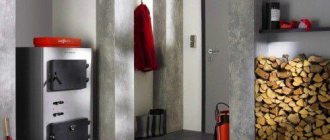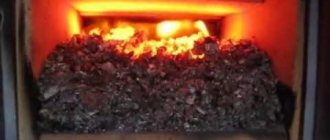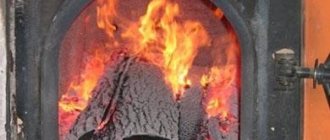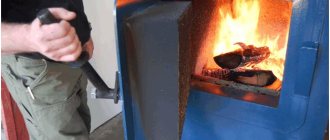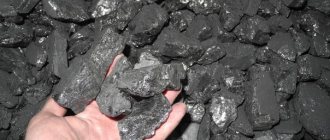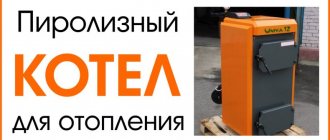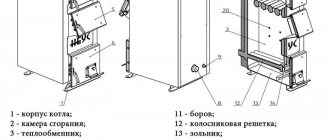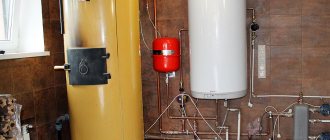Firewood and wood are in 1st place. At the beginning of the conversation, we ask customers who purchase a solid fuel boiler, what exactly do you plan to heat your premises with? About 80% answer - firewood. Yes, Belarusians heat their boilers with wood, not coal, not briquettes, not pellets. But firewood is different from firewood. What kind of firewood do you prefer to fire your boiler? What kind of firewood is good for us and what kind of wood does your solid fuel boiler like? What characteristics should they have? How many do you need? We will try to answer these and many other questions in this article.
When choosing and buying a boiler, just imagine how many fires you need to light, how many times a day you need to throw them, how often you will clean the boiler and chimney. Therefore, choosing the type of boiler and buying a boiler with optimal characteristics at the best price is a very difficult task. A good solid fuel boiler should save wood, time, and money on maintenance.
The main requirement for firewood for heating a house in general and for a modern solid fuel boiler is the longest possible burning of solid fuel and maximum heat transfer to the premises. It must be taken into account that each type of wood has its own unique characteristics, so some types are suitable for the construction of buildings, furniture, flooring, and some for fireboxes. The main characteristic for the purpose of heating a private house is the density of the wood structure: the denser the structure, the longer the wood will burn and then smolder in the combustion chamber of the boiler, giving off heat. But such firewood is difficult to light, so it is better to start kindling with looser varieties. One of the fundamental characteristics of suitable firewood is the amount of smoke and ash released during combustion.
So, let’s first look at what solid fuel boilers prefer by breed:
Bestseller!
Solid fuel boiler Sakovich W Standart 10 kW
The advantage of the boiler is a large combustion chamber and large loading doors, operating time on one load, simplicity and durability of the design, and the ability to be used in a non-volatile system. Reviews (2)
RUB 2,036 Buy
Bestseller!
Economic features of various firewood
The lowest temperature when burning poplar wood
The shape matters: the smaller the logs, the easier they ignite and burn faster. It is clear that the length also depends on the design: too long cannot be placed in a stove or fireplace; the ends stick out. Too short - extra labor when cutting or chopping. The combustion temperature of firewood depends on the amount of humidity, the type of wood, and the amount of air supplied. The temperature is lowest when burning firewood from poplar, highest when burning hardwood: ash, mountain maple, oak.
The importance of humidity was written above. Not only the heat transfer of fuel in the furnace, but also the labor costs for splitting or sawing greatly depend on it. It is easier to split and saw damp, freshly cut wood. However, it is too wet and viscous, which makes it hurt badly. The butt part is denser, and uprooted stumps and areas near knots have increased strength. There the layers of wood are intertwined, which makes it much stronger. Oak splits well in the longitudinal direction, which has been used by coopers since ancient times. Getting shingles, shingles, and splitting firewood has its secrets.
Spruce firewood
Spruce is a “shooting” species, which is why it is undesirable for use in fireplaces or fires. When heated, the internal “bubbles” with resin boil and throw burning particles quite far away, which is dangerous: it is easy to burn clothes near a fire. Or may cause a fire near the fireplace
In a closed furnace firebox this does not matter. Birch produces a hot flame and is excellent firewood. But with poor traction, a lot of resinous substances are formed (before they used to make birch tar), a lot of soot is deposited
Alder and aspen, on the contrary, produce little soot. Matches are mainly made from aspen
But with poor draft, a lot of resinous substances are formed (before they used to make birch tar), and a lot of soot is deposited. Alder and aspen, on the contrary, produce little soot. Matches are mainly made from aspen.
In practice, it is convenient to immediately saw and split freshly cut firewood. Then stack it under the awnings, making woodpiles so that air passes through, drying the fuel and increasing heat transfer
Chopping wood is a labor-intensive task, so when buying, pay attention to this. In addition, they will bring you stacked or bulk firewood. In the second case, heating oil is placed in a “loose” body, and the client pays partly for the air
In addition, liquid or gaseous fuel used for heating has an advantage: it is easy to automate the supply. Firewood requires a lot of manual work. All this should be taken into account when choosing a stove or boiler for your home.
In the second case, heating oil is placed in a “loose” body, and the client pays partly for the air. In addition, liquid or gaseous fuel used for heating has an advantage: it is easy to automate the supply. Firewood requires a lot of manual work. All this should be taken into account when choosing a stove or boiler for your home.
Solid fuel boiler Defro KDR 35 kW
Long-burning floor-standing boiler with a longer firebox and manual fuel supply. Efficiency 81%. Automation S3P with PID function (OPTIONAL). Heat-resistant boiler steel P265GH 6 mm thick. Includes mechanical regulator RT-4. Power 35 kW. Reviews (2)
RUB 6,166 Buy
Bestseller!
Pros and cons of wood heating
The most important advantage, because of which heating a house with wood is becoming increasingly popular, is, of course, the price of the issue. If we do not take into account the cost of natural gas for users in the Russian Federation, then wood and wood waste are guaranteed to take first place according to this criterion. We should not forget that not all settlements and houses in the Russian Federation are gasified.
Another real advantage that stove or water heating of a house using solid fuel gives is environmental friendliness and the feeling of comfort that comes from the smell of fresh and burned wood. The burning of a fireplace or stove with a transparent panoramic screen built into the loading door is visually pleasing. Unfortunately, that's where the positives end.
For the low cost of firewood as an energy source, we will have to pay with our own time and physical labor.
You will have to work when preparing solid fuel, lighting a stove or solid fuel boiler, as well as to maintain their operation, periodically adding new logs. If you take purely stove heating, then it is difficult to warm up remote rooms; you still need to use radiators. Installing a wood-burning boiler is not a cheap undertaking, since it must be properly wired and additional equipment installed.
Solid fuel boiler MAYAK KTR-20 EKO MANUAL UNI 20 kW
Floor-standing, solid fuel, single-circuit long-burning boiler. With an open combustion chamber, with cast iron grates. Steel thickness 6 mm. Power 20 kW. Possibility of installing a pellet burner (optional). Country of origin: Ukraine. Reviews (2)
RUB 3,743 Buy
Manufacturer's products are presented at the exhibition
Bestseller!
The most popular solid fuel is firewood
General properties of firewood
The word “ordinary” used above is probably not entirely correct. The fact is that firewood can differ very significantly in its “abilities” and ease of use. And this depends on many factors, including the type of wood, harvesting and storage conditions. Therefore, it would be more correct to say that this is the fuel most familiar to Russian householders.
Different types of firewood can differ quite significantly in their performance characteristics.
But first, let’s talk about what makes firewood especially attractive to owners of stoves and boilers.
The advantages of this type of solid fuel include the following:
- First of all, it is availability in most regions of Russia. Of course, they are not the same everywhere in price and in the types of wood offered. But basically this type of fuel becomes the cheapest, and in some places it is almost “free”.
- In the fair opinion of most homeowners, no other type of fuel is capable of creating as comfortable and cozy an atmosphere in the home as natural wood. This is the characteristic smell, the usual calming crackling sound, and the very sight of burning logs.
There is a completely fair opinion that no other solid fuel is capable of creating such a cozy home atmosphere
- Firewood has been used for centuries, and this is the experience accumulated by our ancestors. In any case, you know what to expect from such fuel; no “surprises” are expected.
- Durability - firewood can be stored outdoors for a long time (within certain reasonable limits, of course), without losing its qualities. Even signs of biological damage to wood (the appearance of blue discoloration, mold, etc.) still leave the firewood completely suitable for use.
- Combustion waste (ash and ash) does not have any unpleasant odors and is quite easily removed from the furnace or boiler.
- Most modern boilers and stoves on sale are designed to use wood - this is, in fact, a universal fuel for such equipment. Many of these appliances have a special long-burning design that makes maximum use of the energy potential of the burning wood.
Of course, firewood also has its drawbacks , which, one way or another, you have to put up with:
- First of all, this is, of course, volume. Even the “operational” supply of firewood takes up quite a lot of space, not to mention the supply for the entire heating period or for several winters.
- This leads to the second thing - it is necessary to create very spacious places for storing firewood in compliance with certain conditions so that the wood does not become waterlogged and does not deteriorate.
One of the main problems is the need to organize proper storage of very large reserves of firewood, with all the attendant difficulties.
- Irregular shapes of firewood significantly complicate their compact storage.
- Whatever one may say, in terms of its calorific value, pure wood is still inferior to many other types of solid fuel.
- High combustion rate. In addition, in conventional solid fuel stoves or boilers it is difficult to achieve uniform burning of the wood filling. There is a clear difference in the phases of combustion and heat transfer - a rather “lazy” ignition, then rapid combustion with maximum heat transfer, and then the decay phase begins. These negative features are quite successfully smoothed out in long-term combustion units operating on the principle of afterburning pyrolysis gases.
- The burning of wood is accompanied by the release of a large amount of smoke, and unburnt solid waste can account for up to 15% of the initial volume of the stack.
- The wood itself is harmless. But if it begins to be affected by fungus or mold, then during combustion the release of very toxic components cannot be ruled out. This may pose a certain threat to the health of household members.
- Using firewood as fuel requires some physical effort (splitting, storing, carrying, loading, etc.). For people with disabilities this sometimes becomes a big problem.
As you can see, the disadvantages are quite significant, but they do not outweigh the advantages. And firewood still remains, at least in our country, among the most popular types of fuel.
What type of wood is best?
It has already been said that the performance qualities of firewood prepared from different types of wood have very significant differences. It makes sense to briefly consider the most common types.
First of all, the difference is found in the inherent energy potential of one or another type of wood. Simply put, this is the amount of heat that is released when a unit of measurement of the amount of fuel is burned (in weight or volume equivalent). This value is also called calorie content or specific calorific value.
The table below shows the approximate specific calorific value of firewood from various wood species. A little clarification is in order here. This value can be measured in kilocalories per kilogram, in joules. But since we are more accustomed to expressing the power of heating units in kilowatts, it makes sense to immediately reduce the “calorie content” of the fuel to precisely these units of measurement.
| Wood type | Average calorific value of dry firewood by weight (kWh/kg) | Average calorific value of dry firewood by storage volume, kWh/m³ | The same applies to damp wood (which has not undergone at least a one-year drying cycle) |
| Beech | 4.2 | 2200 | 1930 |
| Oak | 4.2 | 2100 | 1850 |
| Ash | 4.2 | 2100 | 1850 |
| Rowan | 4.2 | 2100 | 1850 |
| Birch | 4.3 | 1900 | 1670 |
| Elm | 4.1 | 1900 | 1670 |
| Maple | 4.1 | 1900 | 1670 |
| Aspen | 4.1 | 1750 | 1400 |
| Alder | 4.1 | 1500 | 1300 |
| Willow (willow) | 4.1 | 1400 | 1230 |
| Poplar | 4.1 | 1400 | 1230 |
| Pine | 4.4 | 1700 | 1500 |
| Larch | 4.4 | 1700 | 1500 |
| Fir | 4.4 | 1600 | 1400 |
| Spruce | 4.3 | 1400 | 1200 |
Well, now let’s briefly go over the types of wood.
Firewood made from softwood
Let's start with them, because here everything can be explained as briefly as possible. The fact is that it is better not to consider firewood from coniferous wood as fuel for a stove or boiler for a scrap heating system.
Coniferous firewood is far from the best option for a home heating system
If you look at the table, it seems that they have a very good energy potential, higher than that of most hardwoods. But the adjacent column, in terms of per cubic meter, shows how much they are already losing due to their low density. That is, the volume of firewood required to maintain heat in the house increases significantly.
Further, any coniferous wood is saturated with resins and essential oils. These substances are highly flammable, and laying such firewood burns out much faster than deciduous wood, which is also extremely unprofitable. In addition, resinousness also causes a large amount of smoke, with a high concentration of viscous products. This leads to very rapid overgrowing of both the internal channels of the stove and the chimney.
Thus, firewood from coniferous wood can be used for heating purposes only if it is not possible to use others. The bathhouse is a different matter - here pine logs are more than appropriate, as they are capable of creating a unique bathhouse atmosphere, again, due to the high content of resins and essential oils.
Hardwood firewood
- Birch firewood is probably considered the most popular . They are relatively inexpensive as this tree grows in abundance in most parts of the country. But it is not only availability that makes such fuel widely in demand.
Birch firewood, without a doubt, can be considered one of the most popular
The burning of birch firewood is accompanied by the release of a very special aroma, which, by the way, is not without healing qualities. It is not for nothing that since ancient times, traditional healers have been using the heat of birch trees to fight colds and respiratory diseases.
Birch wood is saturated with natural tar, which, by the way, is a hydrocarbon compound and increases the heat transfer of firewood during combustion. In general, in terms of specific calorie content, birch occupies one of the leading places among widely available species.
The disadvantages, and very serious ones, include the fragility of such firewood. Long-term storage does not benefit them - already two or three years after harvesting firewood begins to lose its advantages. Rottenness appears and heat transfer rates drop sharply. This must be taken into account when organizing fuel reserves - it will constantly need to be “rotated”.
- Oak wood is one of the most efficient for heating . The wood is very dense, with high heat transfer rates. Therefore, it is also very economical in spending. This somewhat smoothes out the very high price of such fuel.
Oak firewood can be considered “elite”, and its cost is prohibitive for many homeowners
Burning oak wood exudes a unique, pleasant, slightly tart aroma that has medicinal properties. And in terms of the heat they create, they have few competitors at all.
By the way, classic Italian pizza is cooked exclusively on oak wood. And in our country, many homeowners create stocks of such logs specifically for cooking on the grill or in a barbecue oven.
If oak firewood is purchased, then preference should be given to those harvested from middle-aged trees. Those that are too thin have not yet “gained the energy of nature,” and old trees, alas, begin to waste it.
- If it is possible to purchase alder firewood , then this is a very good option. This fuel has many advantages.
It is very difficult to confuse alder firewood with any other firewood - they are distinguished by the unusual coloring on the cut of the wood, from yellow, ocher and even outright red. The saturation of the shade depends mainly on the specific species of alder, and there are more than two dozen of them.
Alder firewood is an excellent solution for heating a home. They are difficult to confuse with others due to the unusual colors of the wood.
A very useful quality of alder firewood is its unpretentiousness in drying conditions. Wood actively gets rid of moisture on its own, without absorbing excess from the outside.
For three years after harvesting, alder firewood has aromatic properties. Subsequently, this quality gradually evaporates, but such a loss does not affect the calorific value of firewood. And in general they can be stored for quite a long time.
With high heat transfer, such fuel produces a minimal amount of smoke. By the way, it was alder firewood for this reason that was used to heat the baths “in black style.” And one more important property - the combustion products of alder are an excellent means for cleaning the chimney from soot accumulations. Therefore, it is recommended to create a stock of such firewood for periodic preventive use in any case.
- Aspen firewood has some qualities similar to alder logs, for example, the ability to loosen soot build-up in the chimney and prevent smoke and soot from burning. But in other respects they lose significantly.
Aspen firewood – the efficiency of its use for heating is low
The wood is friable and you will need too much of it to get the proper results. Therefore, if aspen firewood is used, it is for cleaning the chimney and for igniting other, denser firewood - aspen fires very well.
- Linden firewood has a good healing effect, so it is often used in baths, especially in a “duet” with honey infusions. But this wood tends to be very difficult and takes a long time to ignite, however, with subsequent active combustion and high heat transfer.
Linden firewood is very reluctant to ignite, but then gives quite decent heat transfer
Everything seems fine, but the durability of such firewood is clearly not up to par. Two years are usually enough for them to lose their advantages.
- poplar and willow firewood as second-class fuel. They burn out very quickly, without giving the expected heat. That is, too many of them will be required to achieve the required heating of the furnace or boiler.
In a word, their use is justified only in cases where there is no alternative at all.
- Firewood from fruit trees is usually a very high-quality dense fuel with high heat transfer. But their procurement on any scale significant for heating needs is a problematic matter. Unless there is a large-scale cutting down of an orchard in the immediate vicinity.
Firewood from fruit trees is usually very high quality fuel. The only question is where to produce it on a noteworthy scale?
Of course, it wouldn’t hurt anyone to have a supply of such firewood. It’s probably better not to come up with anything for a smokehouse, grill, barbecue, or barbecue.
Concluding the issue with firewood, we note a few more recommendations.
- The quality of firewood always depends very much not only on the type of wood, but also on the degree of drying. Freshly cut firewood should not be used - it will produce a lot of smoke and soot with much less heat transfer than expected. The table above clearly shows this difference.
- The highest quality fuel is obtained from trees felled in winter; there is practically no sap flow in the trunks. Such firewood dries quickly and has maximum energy potential. At the same time, sawn logs must be thoroughly aged and ventilated for four to six months before chopping and placing in woodsheds.
- Firewood from trees felled in spring or summer is usually not ready by the beginning of the heating season. That is, these are already reserves for at least next year.
We will not dwell on the conditions for storing firewood here - this is a whole “science” that requires separate consideration. And such an article will soon be published on our portal.
You might be interested in learning about what features wood stoves provide
OAK
Oak firewood is the most ideal option for a boiler. Wood burns for a long time and produces the greatest amount of heat. But they are also the most expensive. It is also quite difficult to chop them into the necessary parts, and when igniting, oak firewood is difficult to ignite. But due to their high cost, you can add several logs to another type of fuel when burning in the firebox. When choosing such firewood, you should choose middle-aged oak. Our ancestors said: “There is a withered oak tree, the devil sits in it; whoever approaches will not leave”
Pellets
Pellet boilers are one of the most advanced solid fuel systems.
Pellets are small fuel granules that look like oblong cylinders 2–4 cm in length and about 7 mm in thickness. The raw materials for their production are waste from wood production: sawdust, wood chips, bark, as well as substandard wood, which is unsuitable for other purposes.
Expert opinion
Torsunov Pavel Maksimovich
Depending on the proximity of waste sources, pellets may also include agricultural waste - husks, dried stems, husks. Sometimes peat or coal chips are added to pellets, which increases their calorific value.
Pellets are produced by drying and pressing. When the mixture is subjected to pressure, the temperature inside it increases, lignin, a component of wood, is released, which firmly glues the particles together.
Torrefied fuel pellets are considered the most valuable fuel. They burn without oxygen, acquiring a dark color. Due to this, their heat capacity increases. In addition, they are not afraid of moisture and do not crumble over time.
Pellets have a number of advantages:
. Pellets are made not just from wood, but from production waste, which otherwise would go to a landfill or recycling incineration. The use of agricultural by-products, which are regarded as nothing more than garbage, makes pellets one of the most progressive types of solid biofuels.
Environmental friendliness and production using waste-free technology- High combustion efficiency . Thanks to the production technology, pellets contain a small amount of moisture - only 8 - 12%, while naturally dried wood will still contain 25 - 30%, and fresh wood - 50% or more water. Burning pellets produces approximately twice as much heat as burning wood. If we compare the calorific value with hydrocarbons, it is only two times less than when burning fuel oil or gas.
- Low ash content . Pellets are practically devoid of the main drawback of wood - they form a small amount of non-combustible residues, and the content of soot and soot in the smoke is reduced. The share of ash in the granules is only 3%, so boilers and chimneys when using them require less frequent cleaning.
- Good transportability . Due to relatively high mechanical strength, small size and high density, pellets are light and easy to transport. At production, they are packaged in various containers weighing up to one ton in big bags and can be delivered by any type of transport.
- Possibility of automated feeding . Due to the identical sizes of small granules, they can be fed into the boiler automatically, using special dispensers, Archimedes screws and other devices. This allows the solid fuel boiler to be endowed with a high degree of autonomy.
Unfortunately, pellets have two significant disadvantages:
- The high cost, which arises from production costs: drying, pressing, firing. Therefore, compared to other wood fuels, the cost of pellets will always be higher.
- Enterprises that produce fuel pellets are not located in all areas. Buying pellets with delivery over long distances can completely negate their economic advantages.
Pellets are most widespread in European countries, where environmental fuel is in greatest demand. The possibility of useful recycling of waste, coupled with high energy efficiency, makes it the number one solid fuel, especially since there are almost no large forest areas allowed for felling in Europe.

